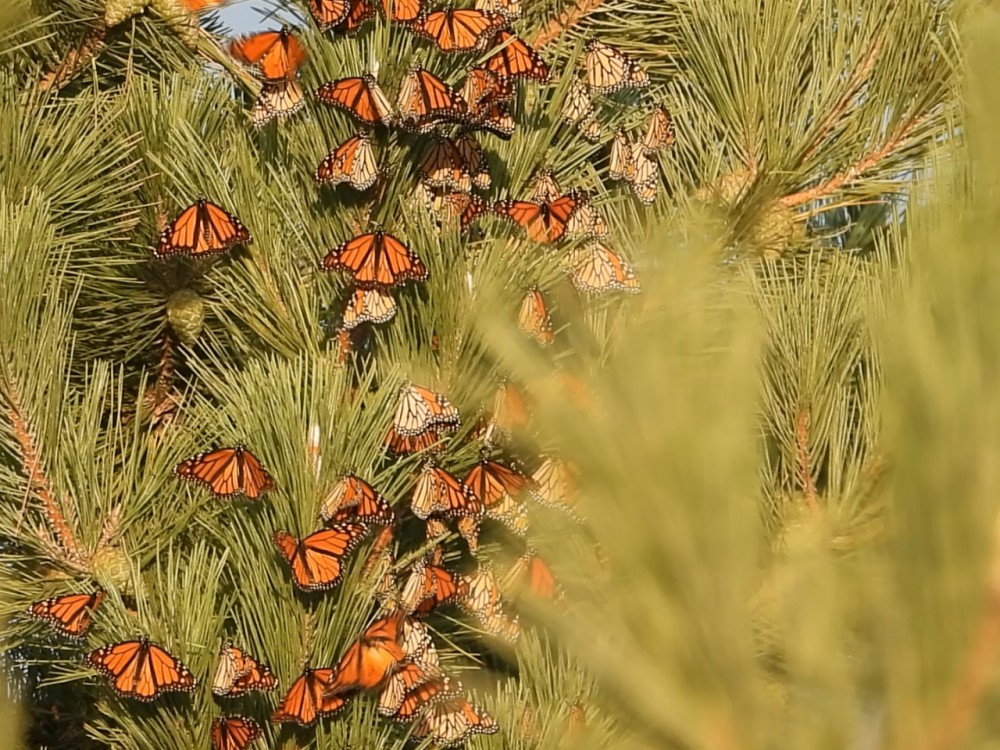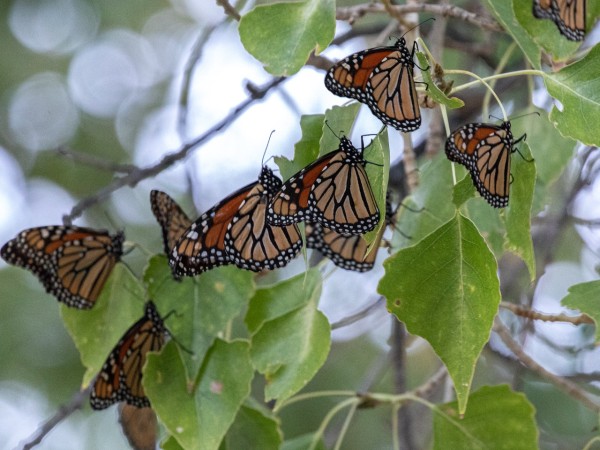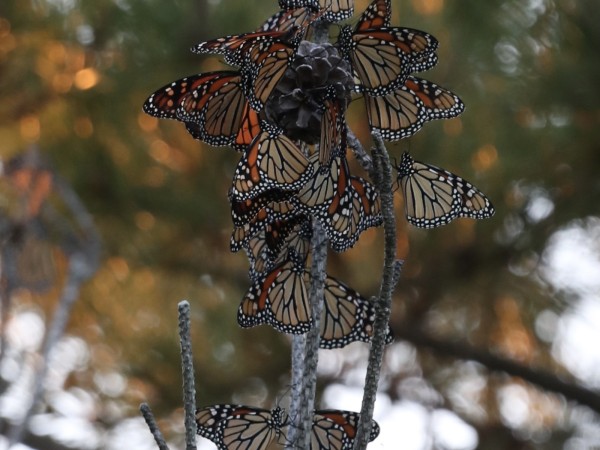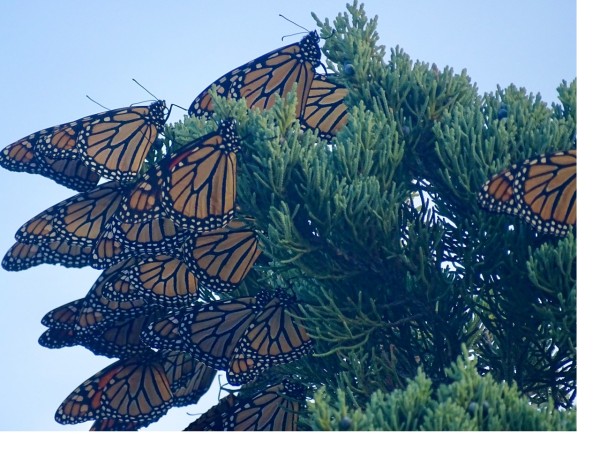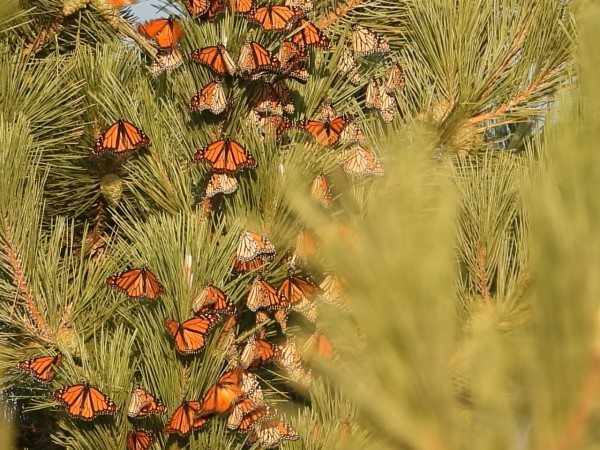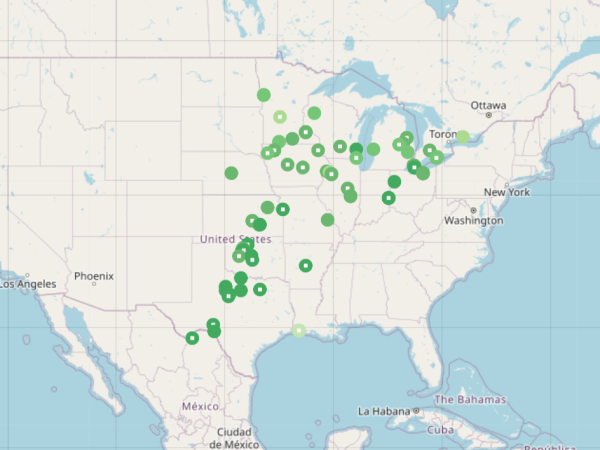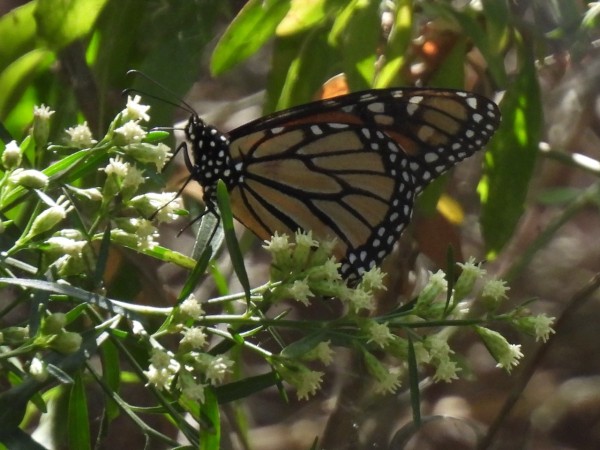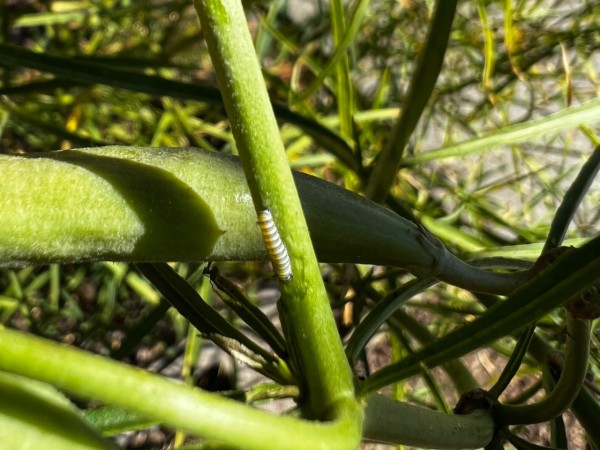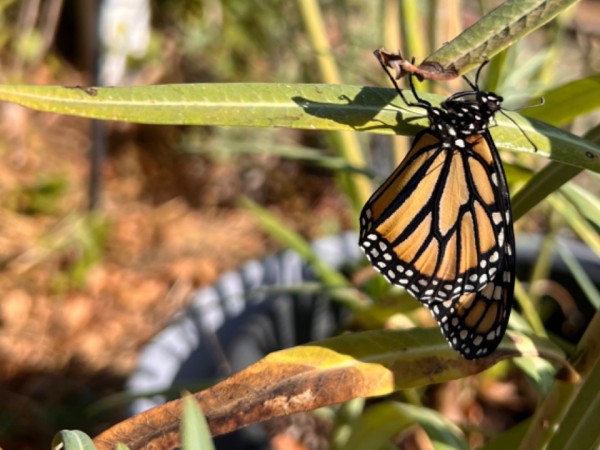Roosts ramp up in Texas, many volunteers reporting late sightings
While monarchs are making their way toward their winter destination in Mexico, many people are still seeing them as far north as latitude 47 on the North Shore of Lake Superior. What are we to make of this year’s fall monarch migration?
Roosts in Texas and the Northeast
Last week was a big one for monarch roosting in southern Texas, with reports from June, Abilene, Rule and Big Bend National Park numbering as many as 1,000 individuals. At the same time, we’re seeing the first roosts of the year at Cape May on the southern tip of New Jersey, more than 1,700 miles to the northeast.
The Cape May Monarch Monitoring Project, an education and research program of NJ Audubon’s Cape May Bird Observatory, posted on Facebook that 230 monarchs were spotted on Oct. 8, following reports of over 400 in the organization’s Oct. 7 report:
“Monarch numbers have been building from late this afternoon, into this evening with hundreds moving down the coast and through Cape May Point!
Anna, one of our Monarch Field Naturalists, counted over 400 in a 30min period while conducting our point count around 3pm. Additionally, over at the Avalon Seawatch, Tom Reed recorded 30-50 per minute this evening heading south toward Cape May.
After several weeks of winds from the east we are finally seeing some Northwest winds today and are expecting more throughout the week. It will be Northwest again tomorrow, which should push more numbers of Monarchs into Cape May.”
On the south end of Long Island, New York we also received a report from Barbara on Fire Island of 600 monarchs on Oct. 8, as well as 300 reported by Bridgette in a similar spot the following day.
“On a beautiful fall day I finally spotted the migration, very late this year. From 5 pm-6:30 I walked 3 miles and spotted over 600 monarchs. The sun was out with a moderate south-west wind and temps in the low 60's,” Barbara wrote. "The monarchs all looked healthy and were feeding on various plants specifically goldenrod. Many were gathering in roosts for the night. The roosts were larger with 20 plus monarchs at each roost. Some monarchs were even roosting in the golden rod. It was such a spectacular sight to see the monarchs gliding through the air.”
These were some of our first reports of roosting along the Eastern Flyway aside from an Oct. 7 report from Gayle at Cape May Point. If you’re seeing roosting monarchs along the Eastern Flyway or anywhere else, let us know!
We have received more reports from the Central Flyway, helping illustrate the path monarchs take as they funnel from Canada and the Great Lakes States down into Texas.
While roosting is taking place in Texas, that doesn’t mean it’s all done in spots a little farther north. We continue to receive reports from Point Pelee National Park in Ontario, on the north end of Lake Erie, though the number of monarchs decreased to 61 with the Oct. 9 report after reports of 210 on Oct. 4 and over 1,000 on Oct. 3. In Richmond, Indiana, Dianna reported 31 on Oct. 4.
Toby reported 45 flying overhead in White Sulphur Springs, West Virginia on Oct. 6, writing, “We counted 45 monarchs during a 90 minute brunch. They were coming 1 after another. Most flying low, just over our heads as we dined. Some were flying about 1 story high All were flying in a southerly direction. A couple stopped to nectar on some asters. A beautiful sight to see!”
Late sightings of adults, larvae
After a late summer peak observed by Monarch Larva Monitoring Project volunteers, many people have been reporting that they’re seeing monarchs later in the season as well, including caterpillars.
On Oct. 4, Cindy in Nashville, Illinois reported a chrysalis and a caterpillar, writing, “We're going to have warm, dry days ahead. This was quite a surprise. My Monarch Chrysalis is doing well and is about 8 days into the process. Fingers crossed all goes well for both.”
Last year’s latest larvae report from Illinois was submitted on Sept. 22 by Sally in Taylorville, Illinois.
Aline in Meteghan, Nova Scotia (latitude 44.2) reported three larvae on Oct. 7, writing, “There are 3 larvae in all from a group of 12 that I saw on Sept 12th. 2 are quite plump and will definitely go in chrysalis soon. Our temps are cool, around 14c during the day and 8c at night.”
We didn’t receive any larvae reports from Nova Scotia in September or October last year, but it’s not unheard of to see caterpillars this late. Last year, we received a photo of a chrysalis from Janet in Burlington, Massachusetts (latitude 42.5) on Oct. 29 and another from Karl in Deer Isle, Maine (latitude 44.2) on Oct. 5.
We’ll see over the next few weeks whether caterpillar sightings persist in these areas, or if these are the final observations of the season before temperatures dip. The temperatures in many areas appear to be favorable for monarchs over the next few weeks, though food availability may shrink after a fall frost.
In Nashville, Illinois, for example, temperatures are projected to remain in the 80s through the weekend before a few days in the 60s, after which they’ll return to the 70s, according to the Weather Channel.
It's not quite as favorable in Nova Scotia. In Meteghan, the Weather Channel's forecasted highs range from 50 to 62 degrees, with lows between 39 and 50.
Generally, monarchs need air temperatures of at least 50 degrees on a sunny day or 60 degrees on a cloudy day in order to fly.
Keep your reports coming
Your reports help us see what’s going on throughout the monarch’s range, and not just the extremes like fall roosts in the hundreds or late larvae. Even your sightings of a single adult are important. Keep the reports coming to Journey North!
Western monarchs update
Gail Morris, Southwest Monarch Study coordinator
It’s been a HOT grand opening to October this year! Historical record highs have been shattered across the Southwest this week as a heat dome stays entrenched over the region, limiting monarch activity in some locations. Hopefully, cooler weather will be on its way by the end of this week, accompanied by an uptick in monarch activity as well.
Recent Monarch Sightings
Journey North maps reveal Monarch adults were reported scattered across the lower two-thirds of the West in Utah, Nevada, Oregon, Arizona and California in low numbers this first week of October. Other life stages were also seen, also late in the season.
Molly in Moab, Utah reported one on Sept. 30, writing, "I rarely see monarchs here, so thought I’d see if there is a way to report the sighting! I’m sure it was a monarch and not a swallowtail."
C.J. in Mesilla, New Mexico wrote on Sept. 30, "They seem to be scarce this year. This is the only one I've seen."
Alexandra in Sea Ranch, California, watched monarchs arrive around her butterfly bush to nectar on Sept. 23. “Half dozen seen early this morning, then roost appeared around noon.” Eventually the roost grew to 36 monarchs.
Nancee in Carlsbad, California, checked her milkweed for eggs on October 2. She found “at least a dozen eggs found on milkweed plants laid fairly recently, if not today.” In Oakland, California Leona, found three larva while collecting milkweed seeds on Sept. 28.
Cindy in Valley Center, California posted a photo of an adult on Oct. 7, writing, "Found this beauty just after eclosing near soon to be dormant milkweed. The heatwaves and ashes from wildfires up north affected my milkweed gardens but some late ones were able to make it through the lifecycle."
From the Field
Diana Magor, Santa Cruz, California:
“Today I visited Lighthouse Field at 1:00 and observed about 10 monarchs roosting on the shady north side of a huge eucalyptus just west of the enclosed “official overwintering site”, but really is a part of the same grove.
“I wouldn’t describe it a “cluster” because they weren’t all close together, but they all reacted simultaneously and flew about, and then returned to the same location after I stopped moving along the path. I did get several photos -none very good. I had also seen two or three flying about the sanctuary prior to this. It was hot, (80°), clear and sunny with a light sea breeze.
“I have seen monarchs every day in my garden and on walks in the neighborhood, but this was the first time this season I’ve seen any aggregations. It’s been very hot here - in the 90s for the past couple of days, and more expected for two more days, then a big cooldown next week. Too hot for me to try to tag yet.”
Kristy Brauch, team lead, Los Angeles County, California:
Oct. 4, 2024: “Los Angeles County reports show little change since the beginning of September. Weekly surveys continue to record zero juvenile monarchs despite the presence of both native and non-native milkweed. On Sept. 29, after hours of scouting over two hectares, two males and one female were observed at our botanical site, showing no interest in milkweed. Survey team member Kat Halsey successfully tagged the female, while the males remained out of reach. No eggs were laid, and the site has shown zero counts since. Other sites report reduced activity, though some areas with non-native milkweed show continuous cycles. Our extreme high heat does not appear to affect other butterflies, which remain abundant. With ample milkweed and floral resources available, we remain hopeful that migrating monarchs will arrive in large numbers soon.”
Michele Felix-Derbarmdiker, Riverside, California:
Michele’s activities in California are covered under a Southwest Monarch Study permit with the California Department of Fish and Wildlife.
Collection was done at two sites both native gardens, one in Riverside, CA and the second in Jurupa Valley, CA. Fourteen 4th and 5th instars were collected between Sept. 9 and Sept. 14, found on narrow leaf and tropical milkweed.
Three succumbed to Tachinid flies, two failed to fully develop wings and died shortly after emerging and one formed its chrysalis but succumbed to black death. Eight were successfully reared, tagged, tested for OE and released at their original collection sites.
Gail Morris is the Coordinator of the Southwest Monarch Study (www.swmonarchs.org). She is also a Monarch Watch Conservation Specialist, the Vice President of the Central Arizona Butterfly Association and sits in several Western working groups. The Western Monarch News is based on comments provided to Gail Morris. We hope to increase the number of sightings and therefore photos and comments entered into Journey North. We rely on the volunteers who communicate regularly with Gail and who agree to participate in our effort to increase awareness of the population of western Monarchs. You can reach her at gail@swmonarchs.org

